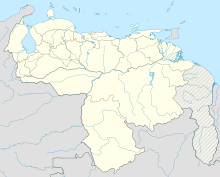Second Battle of La Puerta
changes
 United Provinces of Venezuela
United Provinces of Venezuela Spanish Empire
Spanish EmpireSantiago Mariño
José Tadeo (WIA)
Manuel Cedeño
 José Tomás Boves
José Tomás BovesFrancisco Tomás Morales
9 canons
2 canons
1,500 prisoners killed[1]


- v
- t
- e
| First and Second Republics (1811-1814) |
|---|
|
| Spanish reconquest (1814-1816) |
| Stalemate (1816–1819) |
|
| Bolívar's campaign (1819-1823) |
The Second Battle of La Puerta (Spanish: Segunda Batalla de La Puerta) was fought between Royalists of the Spanish Empire and the Second Republic of Venezuela on 15 June 1814. It was a crushing defeat for the Republicans and a turning point in the war that led to the fall of the Second Republic of Venezuela.
The Battle
The Republicans had won the Battle of Carabobo on 28 May and had become overconfident when they decided to confront the irregular Royalist army, made up mainly of llanero horsemen, commanded by José Tomás Boves. The two armies met at the gorges of La Puerta, near the Sémen River and San Juan de Los Morros, in the current state of Guárico.
During the battle, José Tomás Boves and his forces inflicted heavy casualties on Bolívar's army, resulting in the death of over many of Bolívar's Soliders. Following the battle, over 60 officers were captured and to be executed by firing squad. Among these prisoners was Colonel Diego Talon, who was hanged the day after the battle in Cura.[2]
Bolívar and his men would forced to retreat out of La Puerta, with Bolívar fleeing towards Caracas, while Mariño going to Cumana.[2]
Consequences
On 18 June, Bolívar and Mariño arrived in Caracas with 400 survivors, closely pursued by the Royalist vanguard of Captain Ramón González (1,500 cavalry). On 25 June, José Félix Ribas and 400 cavalry managed to stop González's division and delay its advance to the capital. Meanwhile, Boves had decided to first besiege Valencia with the bulk of his army, but its garrison resisted during 21 days.[3]
The heroic resistance of Valencia, gave the Republicans the time to regroup in Caracas. Ribas only managed to gather less than 2,000 soldiers. It was obvious that it was impossible to defend the capital and on 6 July, Bolívar evacuated Caracas and two thirds of the population, in a long march that is known as the Emigration to East.[4]
References
- ^ a b c d González, Edgar Esteves (2004). Batallas de Venezuela, 1810-1824 (in Spanish). El Nacional. pp. 77–78. ISBN 978-980-388-074-3. Retrieved 25 December 2023.
- ^ a b Ducoudray Holstein, H.L.V (1807–1829). Memoirs of Simon Bolivar, President Liberator of the Republic of Colombia, and of His Principal Generals; Secret History of the Revolution and the Events Which Preceded It, from 1807 to the Present Time. Boston: S. G. Goodrich. p. 65.
{{cite book}}: CS1 maint: date and year (link) - ^ Montenegro Colón, Feliciano (1837). Geografía general para el uso de la juventud de Venezuela. Tomo IV. p.172 Caracas: Imprenta de Damiron y Dupouy.
- ^ Barletta Villarán, Roberto (2011). Breve historia de Simón Bolívar. Madrid: Nowtilus. ISBN 978-84-9967-241-0. pp 119-120
Links
- Cavim
- Historias que merecen ser contadas
- Bibliofep











